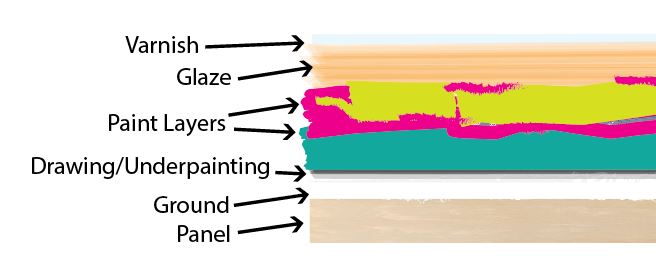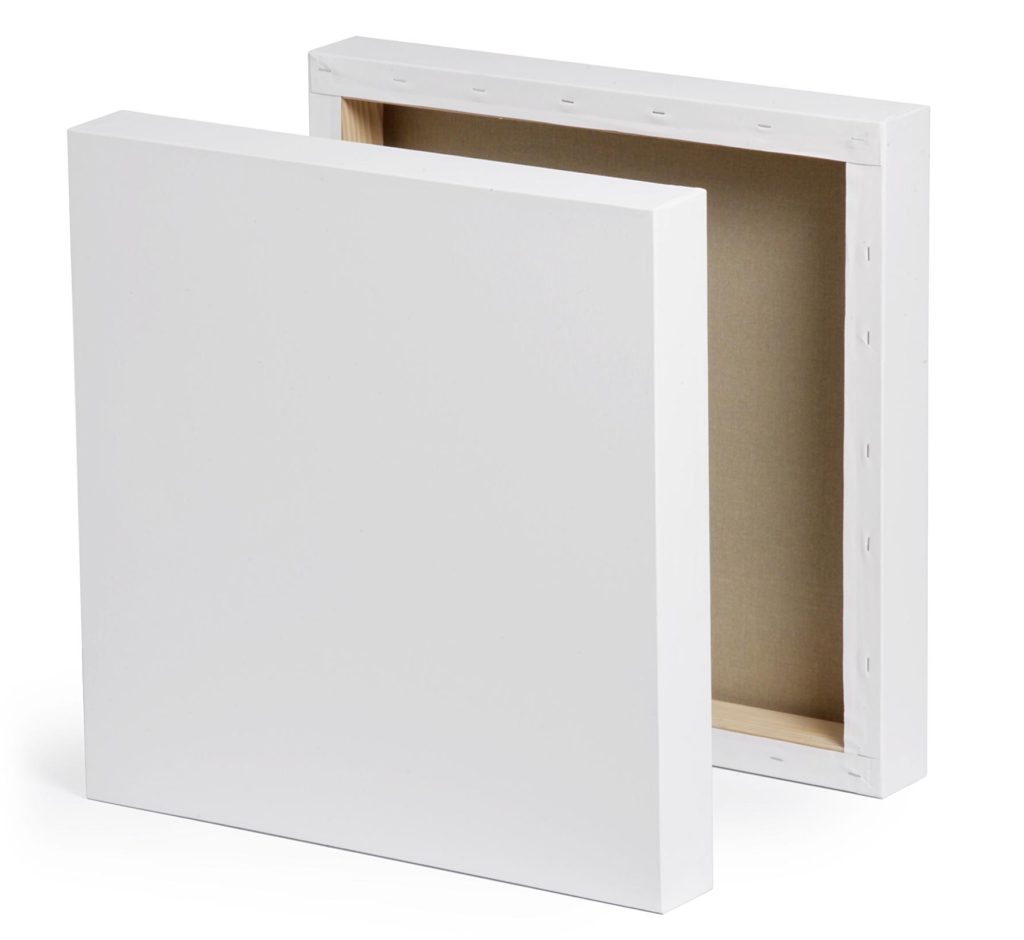Controlling Surface Quality: A Holistic Approach
The anatomy of an oil painting
While the type of surface quality (gloss, satin, or matte) greatly depends on the aesthetic of the artist or collector, surface quality plays an important role in creating a unified, finished appearance.
The surface quality is often determined by the final layer of varnish. However, the materials and techniques used throughout a painting can affect each subsequent layer of the painting – all the way up to the varnish. This discussion of Controlling Surface Quality starts from the ground up, showing how each layer of the painting structure affects final surface quality.

 Painting Surface
Painting Surface
The different layers that are applied onto a painting’s support (surface) create the “anatomy” of an oil painting. The most common supports are stretched fabric (canvas or linen) and wooden panels. Generally speaking, oil paintings age better on rigid supports because the paint film is not subjected to movement throughout the life of the painting – and is thus less prone to cracking. Adhering fabric onto panels is also a popular choice for artists.
Ground
The choice of ground is often the most overlooked component in controlling the overall surface quality. Through 500 years of oil painting, different grounds have been used to build permanent paintings:
- Acrylic Dispersion Grounds: Commonly referred to Acrylic “Gesso”, this is an absorbent ground for use on flexible or rigid supports. Artist’s grade acrylic “gesso” is formulated with enough “tooth” to create a physical bond with oil paint. Be cautious of economy-grade acrylic gesso, which is often too slick to encourage a mechanical bond with paint layers.
- Oil Ground: a non-absorbent ground for use on flexible or rigid supports. Gamblin’s Oil Painting Ground is an alkyd-based, bright-white ground that dries quickly with greater flexibility.
Absorbent grounds will pull more oil out of the paint film into the ground. The resulting paint layer will have a matte surface. Non-absorbent oil grounds do not absorb oil from the paint film, so paintings will retain a glossier surface.
Paint Layers
Often painters notice that their oil paintings take on an uneven surface quality after the paint layers have dried. This is because artists’ pigments absorb the linseed oil binder at varying rates. The phenomenon of oil colors drying more matte is often referred to “sinking in.” Absorbent grounds, as outlined above, will pull in more oil out of subsequent layers and contribute to sinking in.
The 98 colors in the Gamblin line can be categorized as high, moderate, and low in their oil – or fat – content. To determine the oil content of a color, look at the paint; the shinier the paint, the fatter it is. For example, Napthol Red is shinier than Cadmium Red, so Napthol Red has a higher oil content. Colors with a higher fat content will dry glossier, while leaner colors will dry more matte. Once painting mediums are added to the paint, the difference in fat content among colors is negligible.
To better judge color saturation, many artists choose to even out the surface before the painting is completed. This brings up the issue of “oiling out” vs. using a retouch varnish. When using retouch varnish, a thin layer of removable varnish is put in the middle of the structure. When “oiling out,” a thin layer of binder is put between other layers of binder, and before long, this all cross-links to become one homogeneous layer. This method is preferable to using actual retouch varnish in the middle of a painting.
How to Oil Out
- Apply a liberal coating of Gamblin 3-in-1 medium to a dry painting. This can be applied to the entire painting or just to the area that needs to be resaturated
- You can alternatively use a 1:1 mixtue of Galkyd + Gamsol, a 3:2 mixture of Galkyd Lite + Gamsol, or a 1:3 mixture of Refined Linseed Oil + Gamsol. Linseed oil will yeild a slower drying result
- Allow the medium to be absorbed into the painting for approximately two minutes
- Wipe off the excess painting medium with a soft, lint-free cloth
After oiling-out, you can immediately continue painting, or wait for the surface to dry before you add more paint.
When oiling-out prior to varnishing, wait until the painting is dry to the touch before proceeding to the varnishing step.
On average, this usually takes a couple days, 3-4 days at the longest. Cold temperatures and high humidity can cause a longer dry time and waiting period before you can varnish. In warm dry conditions the painting may be dry in 24 hours.

Glazing and Varnishing
The final stages of the painting can ultimately determine the type of surface quality the painting will take. Whereas some painters prefer a dead-matte finish, others like the saturated colors and depth obtained by a high gloss. With an understanding of materials, painters can easily achieve their desired surface quality.
First, it is important to make a distinction between a glaze and a varnish. A glaze is a permanent paint layer containing transparent pigment, which add to the “design” of the painting. Paintings may contain multiple layers of glazes or none at all. A varnish layer, on the other hand, is a non-porous, protective layer that is removable for conservation purposes; it serves its aesthetic purpose while also providing protection against dust and dirt.
There is much benefit in applying both the “oiling out” method (described above) and a varnish layer to a finished oil painting. When a varnish is applied, it will often “sink-in” to the absorbent areas while lying on top of the non-absorbent areas – resulting in an uneven surface. The “oiling out” method will even out the surface and, more importantly, even out the absorbency rates on the surface of the painting. The final varnish layer will lie on top of the oiled out painting structure, rather than sink in to the permanent layers of paint.
Customizing Your Surface
So much in oil painting pushes the paint to a glossier surface. Adding a bit of linseed oil or our Galkyd Painting Mediums will increase the gloss level of paint layers. Our Cold Wax Medium is the one medium that can be used to modify this gloss level. When used alone, Cold Wax Medium makes oil colors thicker and more matte. Please note, when adding more than 1/3 cold wax medium to 2/3 oil colors, we recommend painting on rigid supports to prevent cracking.
Ultimately, varnishing is the best way of unifying the dry paint layers with the desired surface quality for your work. But what type of surface is right for the painting? High gloss? Dead matte? Something in between? Finding the appropriate surface quality is a very personal choice. Gloss surfaces beautifully saturate dry paint layers and increase the sense of depth in paintings. Matte surfaces give paint layers a very direct appearance but can lighten the darkest values in a painting. Historically, representational painters preferred a gloss surface because of the increased sense of depth. Abstract painters adopted matte surfaces to enhance the physicality of paint layers. This, of course, is an over-generalization. What’s most important is that you find the right surface quality for your work.
Gamvar Varnish is available in Gloss, Satin, and Matte finishes.
Remember, the varnish layer is the one layer of the painting structure that is removable. If you’re not satisfied with the surface of the varnish, simply remove it with Gamsol and try again!
Additional Resources:
Take me back to the Tips & Techniques menu

